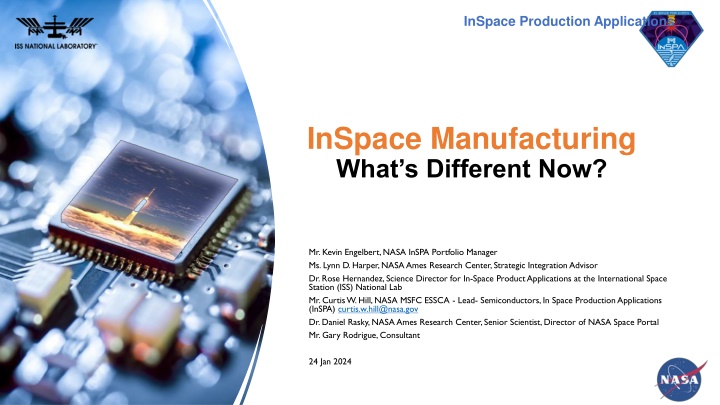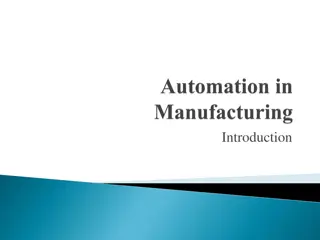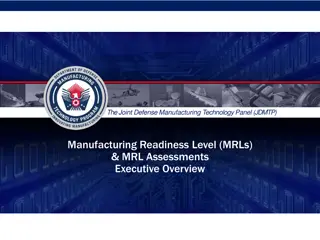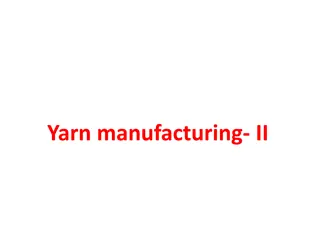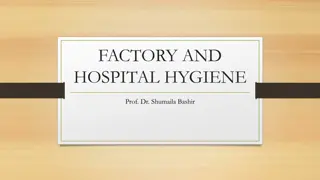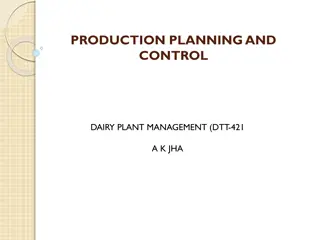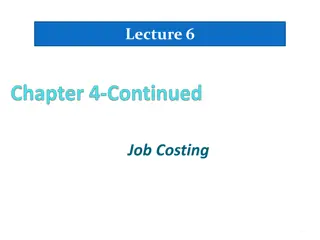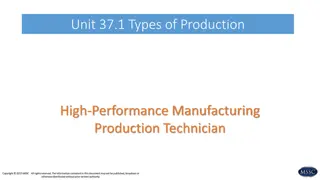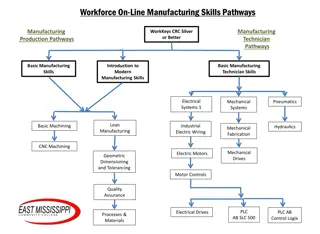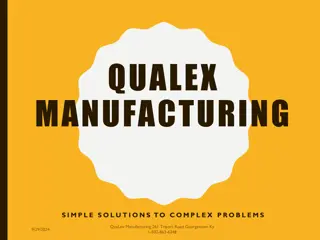Advancements in InSpace Production Applications and Manufacturing
Explore the latest developments in InSpace Production Applications (InSPA) and manufacturing in low Earth orbit, involving key figures from NASA and industry experts. Discover how microgravity can enhance materials and processes at the atomic level, leading to innovative advancements in technology and pharmaceuticals. InSPA's goals include serving national interests, benefiting humanity, and accelerating the space economy through collaboration with the ISS National Lab.
Download Presentation

Please find below an Image/Link to download the presentation.
The content on the website is provided AS IS for your information and personal use only. It may not be sold, licensed, or shared on other websites without obtaining consent from the author.If you encounter any issues during the download, it is possible that the publisher has removed the file from their server.
You are allowed to download the files provided on this website for personal or commercial use, subject to the condition that they are used lawfully. All files are the property of their respective owners.
The content on the website is provided AS IS for your information and personal use only. It may not be sold, licensed, or shared on other websites without obtaining consent from the author.
E N D
Presentation Transcript
InSpace Production Applications InSpace Manufacturing What s Different Now? Mr. Kevin Engelbert, NASA InSPA Portfolio Manager Ms. Lynn D. Harper, NASA Ames Research Center, Strategic Integration Advisor Dr. Rose Hernandez, Science Director for In-Space Product Applications at the International Space Station (ISS) National Lab Mr. Curtis W. Hill, NASA MSFC ESSCA - Lead- Semiconductors, In Space Production Applications (InSPA) curtis.w.hill@nasa.gov Dr. Daniel Rasky, NASA Ames Research Center, Senior Scientist, Director of NASA Space Portal Mr. Gary Rodrigue, Consultant 24 Jan 2024
InSpace Production and Manufacturing Demand How is Gravity Impeding US Industry? 500+ CEOs + CTOs Case Studies NASA g Database Based on work 2013-2016 by NASA s Emerging Space Office and Space Portal enabled by Dr. Alex MacDonald/Program Executive of the Emerging Space Office, Lynn Harper/Space Portal/Study Lead, Dr. Ioana Cozmuta s comprehensive research, with due diligence and insights from Dr. Daniel Rasky, Bruce Pittman, and Mark Newfield and hundreds of experts in dozens of organizations throughout America
more bandwidth faster processors greater energy efficiency specific wavelength applications (lasers) more processing power in smaller volumes better performance in more extreme environments more effective pharmaceuticals and treatments atomic and molecular level precision No end to that demand in sight Even more true in 2024 NASA ESO Findings 2014 Demand Trends in High Tech These demands push materials and processes to the point where defects at the atomic and molecular level matter ... this is where microgravity can help.
In Space Production Applications (InSPA) Turning Discoveries into Applications for the Benefit of All Biomanufacturing & Advanced Materials in Low-Earth Orbit
InSpace Production Application (InSPA) GOALS Serve U.S. national interests by developing materials and technologies that strengthen industry leadership, improve national security, and create high-quality jobs. Provide benefits to humanity by developing products that significantly improve the quality of life for people on Earth. Accelerate development of the space economy in LEO by stimulating demand for scalable and sustainable non-NASA utilization of future commercial LEO destinations. Approach: Increase national workforce proficiency in orbital manufacturing through inflight experience in collaboration with the ISS National Lab 5
InSPA - In Space for Earth Applies lessons from 50 years of microgravity (uG) research and expertise to enable In-Space Manufacturing of advanced materials and products for use on Earth. Invests in US innovators through annual proposal opportunities to develop high value applications that benefit the nation, humanity, and the economy over the next 10 years and the proficiency to achieve them in space. Technical support to help US businesses successfully navigate Technology and Manufacturing Valleys of Death in space until private investment takes over. Collaborative implementation with ISS National Lab. Recruiting subject matter experts from USG Agencies, Industry, and Academia to inform national priorities and accelerate learning in g. Workforce development through hands-on flight experiences in multiple areas researching, developing, testing, and operating high tech payloads in parabolic aircraft, suborbital, and orbital space for solutions that benefit Earth.
InSPA: Build. Fly. Learn. Fix. Improve. Iterate. Repeat till Succeed. Through Technologies Valleys of Death to Applications via Practice in Space Primarily Government Primarily Government Enabling Government Support More Private Investors Government as Customer IRAD, Angels, Philanthropists Some Private Investors HIGH Orange shows transition to Inspace Production Applications (InSPA) Space Investors by TRL Private Investment Risk Manufacturing Process Valley of Death Technology Valley of Death DISCOVER LAB POC Y In Space Manufacturing Transition to Transition to Manufacturing and Scaleup Demos SPAC E POC Application SPAC E DEM Primarily Private Investors LOW TRL 9 TRL 1 TRL 2 TRL 3 TRL 4 TRL 5 TRL 6 O TRL 7 TRL 8 System Proved and Operating in Space with Sales Application Idea Formulated Lab Testing and G Feasibility Validate in space Manufacture in space Scaleup in Space Flights on ISS NASA SMD and ISS National Lab SBIR + STMD Flight Opportunities ISS National Lab+ ISS NRA > ISS Flight > COMMERCIAL/APPLICATIONS G DEMO PROOF OF CONCEPT & QUALITY COMMERCIAL/ APPLICATIONS TRANSFERRED BASIC and APPLIED RESEARCH NASA Biological and Physical Sciences, ISS National Lab
So about Space and Materials What s Different Now?
507 Crystals Grown in Space since 1973 Updates to the data of microgravity crystallization have upheld the conclusions of the preliminary report: microgravity was a beneficial environment for crystallization regardless of crystal type. Microgravity Crystal Formation. Crystals 2024, 14(1), 12; doi.org/10.3390/cryst14010012
507 Crystals Grown in Space Improvement in more than one parameter Microgravity Crystal Formation. Crystals 2024, 14(1), 12; doi.org/10.3390/cryst14010012
495 Crystals Grown in Microgravity Compared to Earth Over Past 50 Years Crystals are bigger, more uniform, and have improved structural quality. Butler databases have been scrubbed of negative results from crystal data that failed due to technical failures (software/hardware), vibration from takeoff or landing, or other failures that impacted the experiment that had nothing to do with crystal formation. In addition, there is a column in each of the datasets that indicates if the results have been independently validated or are from the peer-reviewed literature.
InSPA Centers Crew CLDs Inventors Investors Integration Partners ISS ISSNL/CASIS Launch Services MO&I NASA BPS NASA LEO Comm NASA OZ NIH NST NSF OGAs Payload Services Pharma Safety SBIR Scientists SHERPAs SMEs STMD Flight Opportunities Technologists US Industries It takes a village 3/26/2024 13
NASA InSPA and ISS National Lab Proposal Opportunities On NSPIRES https://nspires.nasaprs.com/external/ Search for ISS NASA Research Announcement (NRA) NNJ13BG001N Focus Area 1 (InSPA) See ISS National Lab Research Announcements https://www.issnationallab.org/research-on-the-iss/solicitations/
Journal Articles with Database Links - DOI: 10.1021/acs.cgd.2c01056 An Analysis of Publicly Available Microgravity Crystallization Data: Emergent Themes Across Crystal Types. Hannah Wright, Amari Williams, Ashley Wilkinson, Lynn Harper, Ken Savin, and Anne M. Wilson. Crystal Growth & Design 2022 22 (12), 6849-6851. DOI: 10.1021/acs.cgd.2c01056 NASA InSPA Microgravity Crystal Formation. Crystals 2024, 14(1), 12; doi.org/10.3390/cryst14010012 Wilkinson, A.; Brewer, F.; Wright, H.; Whiteside, B.; Williams, A.; Harper, L.; Wilson, A.M. Semiconductor Materials Fabricated in Microgravity; A Meta-Analysis. Discov. Mater. 2023; manuscript under review. [Google Scholar] Butler University Microgravity Crystal Database Downloads Direct download from Google Sheets: The databases utilized for these studies can be found at the following links: macromolecules/organic compounds https://docs.google.com/spreadsheets/d/1JrXe4Drne7JKcU4EKG7ObQDfr m6EzrZkneTCrPyYZos/edit#gid=1461894258, https://docs.google.com/spreadsheets/d/1PZ8AAZlXYAln4d2UNR4x_zu- rpkWK8ByG04KiprAAXM/edit#gid=1518976417,
Kevin Engelbert, NASA, InSPA Portfolio Manager kevin.englebert-1@nasa.gov Curtis Hill, NASA, InSPA Lead for Semiconductors Curtis.w.hill@nasa.gov For Further Information Dr. Rose Hernandez, Director InSPA for ISS National Lab rhernandez@issnationallab.org
